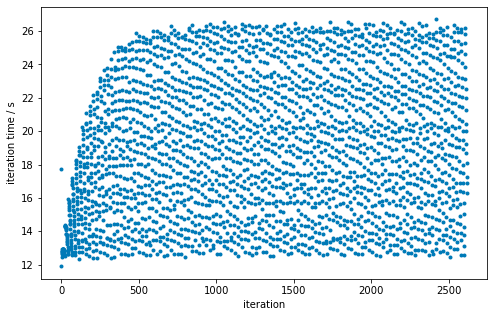Replica propagation times systematically change in cyclic patterns that may slow simulations
See original GitHub issueIn plotting the total replica propagation time per iteration from one of @hannahbrucemacdonald’s experiments (/data/chodera/brucemah/relative_paper/dec/jnk1/lig20to8/complex_0.stderr), it appears that there is a pattern:
 Connecting successive iterations with lines reveals a clearer pattern:
Connecting successive iterations with lines reveals a clearer pattern:
 Zooming in shows the pattern more clearly:
Zooming in shows the pattern more clearly:
 This is currently just something intriguing, but something we should investigate in the new year since it may lead to speed improvements if we can understand what is going on here.
This is currently just something intriguing, but something we should investigate in the new year since it may lead to speed improvements if we can understand what is going on here.
Issue Analytics
- State:
- Created 4 years ago
- Comments:133 (99 by maintainers)
 Top Results From Across the Web
Top Results From Across the Web
Modelling Oscillatory Patterns in the Bovine Estrous Cycle ...
In BDEs, the components are linked with logical functions. A delay matrix ensures that the components do not influence each other immediately, ...
Read more >Differential roles of sleep spindles and sleep slow oscillations ...
Our new study predicts that sleep replay—repeatable sequences of neural cell firing, which are believed to be the neuronal substrate of memory ...
Read more >The impact of a closed-loop thalamocortical model on ... - Nature
Our computer simulations showed that the propagating wave patterns are influenced by many factors such as intracortical and thalamocortical ...
Read more >Evaluation of Climate Models - IPCC
climate change, of variability on multiple time scales and of regional modes of variability. ... The simulation of large-scale patterns of precipitation has....
Read more >Causal Patterns in Ecosystems: - Project Zero
This module introduces domino, cyclic, and two-way patterns of causality. ... an ecosystem may cause changes in other populations in that ecosystem.
Read more > Top Related Medium Post
Top Related Medium Post
No results found
 Top Related StackOverflow Question
Top Related StackOverflow Question
No results found
 Troubleshoot Live Code
Troubleshoot Live Code
Lightrun enables developers to add logs, metrics and snapshots to live code - no restarts or redeploys required.
Start Free Top Related Reddit Thread
Top Related Reddit Thread
No results found
 Top Related Hackernoon Post
Top Related Hackernoon Post
No results found
 Top Related Tweet
Top Related Tweet
No results found
 Top Related Dev.to Post
Top Related Dev.to Post
No results found
 Top Related Hashnode Post
Top Related Hashnode Post
No results found

Here’s a clue: If I replace the
mcmc_moves—which areLangevinDynamicsSplittingMoves—withLangevinDynamicsMoves, the periodic behavior goes away.I suggest we may want to use
LangevinDynamicsMovefor now and I can debug the MCMCLangevinDynamicsSplittingMovestuff separately. It may have to do with theLangevinSplittingIntegrator, which @maxentile and I need to refine anyway.I think I understand part of what’s going on. I don’t know exactly what’s leading to the specific sawtooth shape we’re seeing. I think it relates to the details of the sampling algorithm, which I’m not familiar with. I’ll explain what I’ve found, and then maybe you’ll be able to fill in the missing pieces.
First some background on how OpenMM computes nonbonded interactions. It uses a coarse-grained neighbor list. Instead of finding the neighbors of individual atoms, it finds the neighbors of blocks of 32 contiguous atoms. This is only efficient if those blocks are compact. Atoms whose indices are close also need to be close in space. That’s fine for proteins, since the atoms are in sorted order by residue. But water is a problem. Each molecule can diffuse independently of every other.
To address that, it sorts the water molecules in a way that groups spatially nearby ones close together in order. That makes the neighbor list efficient. But it becomes less efficient with time as the waters move, so it periodically repeats the sorting.
In this script, a single Context is used for 24 replicas. It loops over them, setting the coordinates for each replica in turn and running just a small number of time steps with it. That means it is frequently simulating one replica with a water ordering that was created for a different replica, and hence is inefficient. Within a few hundred steps it will reorder them and become efficient again. But then it promptly switches to yet another replica.
That’s what seems to be going on. When the iteration time goes up, it’s because the neighbor list has become less efficient and it has to compute more interactions. And if I make it reorder atoms more often, the variation gets smaller (though of course it also has to spend more time sorting atoms).